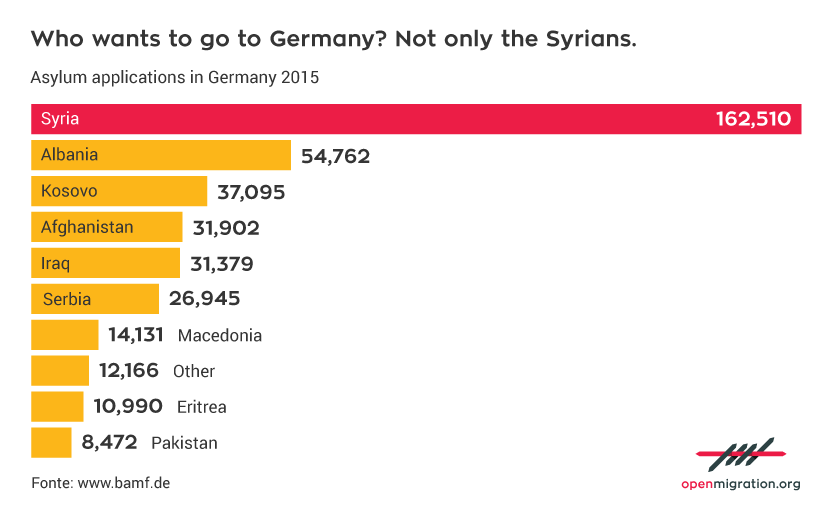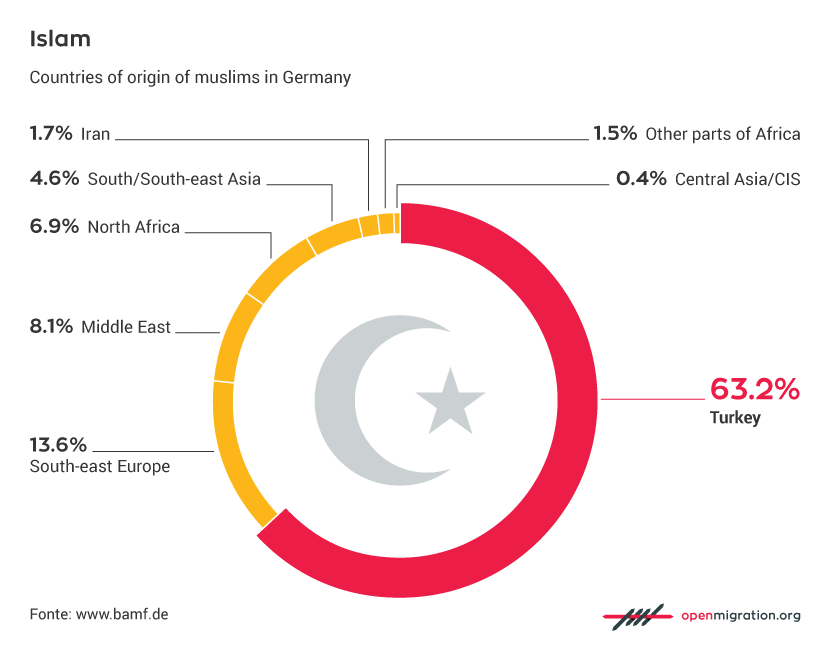The events on New Year’s Eve in Cologne have sparked a debate – often a confused and inaccurate one – over the perpetrators of the attacks, whether they were refugees and immigrants and whether the violence was rooted in Islam. How many refugees are there in Germany, and how many immigrants? How many Muslims? In order to answer these questions accurately, we went looking for data on immigration in Germany and the percentage of Muslims in what is now world’s number two destination for permanent migration after the US, according to the latest OECD ranking.
1. A country of immigrants
Although lately Germany has been often described as a recent destination for immigrants, this is decidedly not the case. According to the Federal Statistical office, a fifth of the population is of immigrant origins, and as shown in the chart below, massive migratory waves have been hitting the country since the 1960s (with 1 million arrivals reached in 1970, nearly touching 1.5 million around 1990).

2. More than 1 million refugees in Germany in 2015
Several German politicians, with Interior Minister Thomas de Maizière and Chancellor Angela Merkel in her New Year’s speech among them, have highlighted how more than 1 million refugees arrived in Germany in 2015. A very high number when compared to that of the asylum requests received by the German Ministry of Interior, or even simply with the 1 million sea arrivals certified by UNHCR and OIM.
These figures (see bottom of page linked) are provided by BAMF – the Federal Office for Migration and Refugees – and are based on the number of registrations filed in the EASY system, which manages the distribution of refugees throughout the various German Länder. That 1 million contains Syrians, Iraqis, Afghans who have accessed Europe through Greece, but also the migrants arriving in Germany through Albania or Kosovo. Even so, the sum of the total asylum applications lodged in 2015 does hardly equal 1 million. The problem might actually reside in the EASY system itself, which does not yet include the acquisition of the refugees’ personal data, making it then possible to create multiple files for the same individual.
Update 25.1.2016: A new OIM report published on January 22 sheds further light on the issue of the 1 million refugees in Germany.
3. The refugees
For refugees, 2015 was the year of hope to be found in Germany through the Balkan route. According to data collected by BAMF, 476.649 asylum requests were lodged in Germany last year (compared to 202.000 in 2014). The highest number was reached in November with 57.816 applications.
In 2015, 43 percent of asylum applicants were granted refugee status, with the highest percentage going to Syrians (98%). The chart below ranks asylum applicants in Germany by nationality.

4. The Syrians
Much has been said about Merkel’s choice to open the doors in September 2015 to Syrians only. «A smart move on the Chancellor’s part to handpick “the best” of migrants: middle-class families from Damascus, ready to be made a part of the German economical apparatus» has been a frequent comment. What is the actual makeup of the Syrian community that has fled the war to seek refuge in Germany? The 162.510 Syrians who have requested international protection account for 33 percent of all the applications lodged in 2015. Women make up 30 percent of all asylum applicants, as do minors (as of October, 16.845 refugees were under the age of 14, and about 5.000 were between 14 and 17).
5. How many Muslims are there in Germany?
The 2008 study Muslim Life in Germany offers the most complete picture of the Islamic religion in Germany. The overwhelming majority of the community lives in the former West Germany (98.4%) and one in three Muslim citizens lives in the great metropolitan area of North-Rhine Westphalia (the Land of Cologne, Düsseldorf, Dortmund and former capital Bonn). The majority of Muslims in Germany are Sunnis (74%), followed by Alevis (13%) e Shiites (7%).










